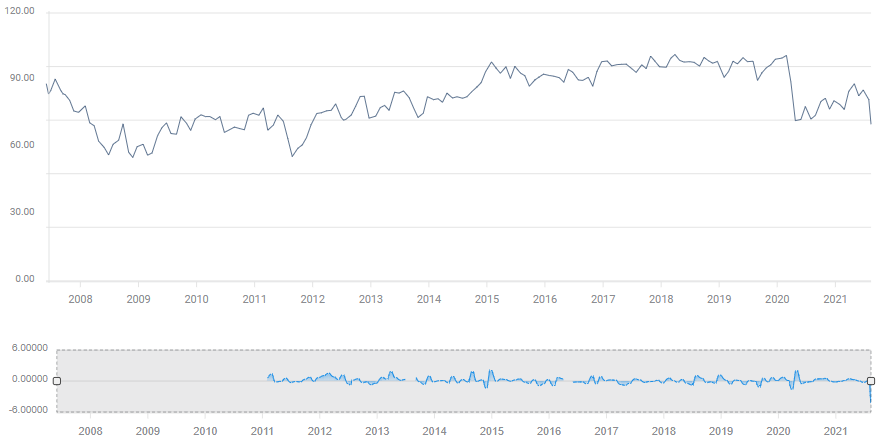- US economic situation may be changing rapidly, and could obviate the information in the minutes.
- Consumer Sentiment in August dropped to an 11 year low, worst of pandemic.
- Retail sales fell 1.1% in July, more than triple the expected drop of 0.3%.
- July 27-28 FOMC statement said economic progress had been made.
At the July 27-28 Federal Reserve meeting, the policy question seemed straightforward. Was the US economy, particularly the labor market, improving enough to begin the taper discussion?
The following sentence had been added to the Federal Open Market Committee (FOMC) statement. " Since then, the economy has made progress toward these goals, and the Committee will continue to assess progress in coming meetings.”
It appeared to be an acknowledgement of US economic progress and perhaps the necessary first step on the path to a reduction of the $120 billion monthly bond program. Markets, however, were wary. The dollar and Treasury yields rose modestly and equities cut some of their losses at the release. The caution turned out to be well justified.
By the time Fed Chair Jerome Powell had finished his news conference, any assumption that the initial taper discussion was near had vanished. The US economy might have improved but, according to Mr Powell, it was still far from the “substantial further progress” of the Fed’s guideline for a change in policy.
Markets reversed, the small dollar and Treasury yield gains turned into losses and equities finished lower.
This is how we covered it at the time, The FOMC giveth and Powell taketh away
Economic data since the FOMC
Since the June 27-28 FOMC the labor market has continued to prosper. Nonfarm Payrolls (NFP) added 943,000 workers in July, which brought the two month average to 940,500, more than double the pace in April and May. The unemployment rate dropped to 5.4% in July from 5.8% in June and the underemployment rate fell to 9.2% from 10%. All of these figures were considerably better than their forecasts.
Jobs remained plentiful. The Job Openings and Labor Turnover Survey (JOLTS) rose to 10.07 million in July, the third all-time record in a row and nearly 800,000 more than June.
JOLTS
FXStreet
Initial Jobless claims continued their slow descent from 400,000.
The economy seemed to be moving to a third excellent NFP report. The Fed was expected to have sufficient comfort with the recovery to begin the taper discussion at the Jackson Hole symposium, hosted by the Fed every summer in late August.
Suddenly, the University of Michigan Survey of Consumer Sentiment reported a precipitous drop in consumer optimism in August. The sentiment index plunged to 70.2 from 81.2. It was the weakest reading since 2011 and the third largest single month drop on record.
Michigan Consumer Sentiment
FXStreet
Consumer Sentiment had been expected to be stable at 81.2 in August
Unexpectedly, the improvement of payrolls and employment was cast into doubt.
Retail Sales in July were far worse than projected, falling 1.1% on a -0.3% forecast. The Control Group dropped 1%, also far beneath its -0.1% estimate. Minor revisions to the June results, from 0.6% to 0.7% for the headline, and from 1.1% to 1.4% for control, did little to negate the dissapointment.
For the consumer dependent US economy, if lower consumption persists for a few months it could short-circuit the entire recovery.
FOMC minutes
The minutes are an integral component of Fed communication and will almost always elaborate on points raised by the statement or Chair Powell, but rarely present new information.
Markets will be seeking clarification of the progress that the economy has made to the Fed’s goals and sense of how many governors were in favor of a quicker lift-off in rates.
Conclusion
The pertinence of the FOMC minutes have been superseded by the Michigan sentiment number and the sharp dip in consumer spending.
Even If the governors had discussed ending the bond program in the fourth quarter of this year or the first quarter of next, that was before Retail Sales declined in July and sentiment plunged off a cliff in August.
The rise of Covid-19 cases in the time since the July FOMC meeting and the continuing high inflation are the likely culprits behind the plunge in Consumer Sentiment and spending.
Whether the plummet in consumer outlook is a temporary reaction to the pandemic and inflation, or the beginning of a period of weakening consumption is unknown, but until the Fed has an answer, changes in rate policy are on hold.
About 70% of US economic activity is tied to consumer spending. If domestic consumption falls while inflation remains high, it creates a painful dilemma for the Fed.
Raise interest rates to quell inflation at the cost of growth and job creation or remain accommodative and exacerbate inflation but support GDP and hiring.
If the Fed has to choose between inflation and job creation, it will choose the latter every time.
Information on these pages contains forward-looking statements that involve risks and uncertainties. Markets and instruments profiled on this page are for informational purposes only and should not in any way come across as a recommendation to buy or sell in these assets. You should do your own thorough research before making any investment decisions. FXStreet does not in any way guarantee that this information is free from mistakes, errors, or material misstatements. It also does not guarantee that this information is of a timely nature. Investing in Open Markets involves a great deal of risk, including the loss of all or a portion of your investment, as well as emotional distress. All risks, losses and costs associated with investing, including total loss of principal, are your responsibility. The views and opinions expressed in this article are those of the authors and do not necessarily reflect the official policy or position of FXStreet nor its advertisers. The author will not be held responsible for information that is found at the end of links posted on this page.
If not otherwise explicitly mentioned in the body of the article, at the time of writing, the author has no position in any stock mentioned in this article and no business relationship with any company mentioned. The author has not received compensation for writing this article, other than from FXStreet.
FXStreet and the author do not provide personalized recommendations. The author makes no representations as to the accuracy, completeness, or suitability of this information. FXStreet and the author will not be liable for any errors, omissions or any losses, injuries or damages arising from this information and its display or use. Errors and omissions excepted.
The author and FXStreet are not registered investment advisors and nothing in this article is intended to be investment advice.
Recommended Content
Editors’ Picks

AUD/USD remains tepid following PBoC monetary policy decision
AUD/USD retraces its recent gains from the previous session against the US Dollar following the People’s Bank of China’s monetary policy decision on Friday. China’s central bank decided to keep its one- and five-year Loan Prime Rates unchanged at 3.10% and 3.60%, respectively, in the fourth quarterly meeting.

USD/JPY: Japanese Yen bulls remain on the sidelines despite strong Japan’s National CPI print
The Japanese Yen adds to the post-BoJ losses and drops to a five-month low against the USD. The Fed’s hawkish shift remains supportive of elevated US bond yields and undermines the JPY. A stronger-than-expected Japan’s National CPI keeps the door open for a BoJ rate hike in 2025.

Gold price oscillates in a range below $2,600 amid mixed cues
Gold price consolidates below the $2,600 mark following the previous day's good two-way price move and remains close to over a one-month low. The Fed signaled a cautious path of policy easing next year, which remains supportive of elevated US bond yields and assists the USD in standing firm near a two-year high.

Bitcoin's trajectory shows similarities with previous cycles as long-term holders book profits of $2.1 billion
Glassnode's Week on Chain report revealed the similarities between the current Bitcoin uptrend and previous cycles amid changing market conditions. Meanwhile, long-term investors began distributing their tokens at the $100K level, culminating in a new all-time high of $2.1 billion in realized profits.

Bank of England stays on hold, but a dovish front is building
Bank of England rates were maintained at 4.75% today, in line with expectations. However, the 6-3 vote split sent a moderately dovish signal to markets, prompting some dovish repricing and a weaker pound. We remain more dovish than market pricing for 2025.

Best Forex Brokers with Low Spreads
VERIFIED Low spreads are crucial for reducing trading costs. Explore top Forex brokers offering competitive spreads and high leverage. Compare options for EUR/USD, GBP/USD, USD/JPY, and Gold.

